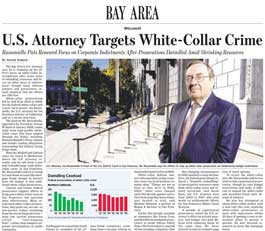A bit more than a month ago, The New York Times launched an experiment that could transform the newspaper industry, and might be the final nail in a coffin shared between the San Francisco Chronicle and the San Jose Mercury News. Seeking to expand its already quite large San Francisco Bay Area circulation numbers (about 49,000 on weekdays and 65,000 on Sundays) the once-gray lady rolled out a twice weekly Bay Area section on October 16th, as well as a Bay Area-centric blog. A few weeks later, the Wall Street Journal (which boasts Bay Area circulation of around 98,000) launched its own section for Bay Area readers. Media critics have lamented these New York-based papers’ aggressive forays into Northern California, arguing that any new competition might topple the region’s two largest papers, the Chronicle and the Mercury News, which have been particularly hard hit in the past few years. It would indeed be a shame to lose the Chron or the Merc. But to the mind of this Bay Area resident (and Sunday New York Times subscriber) the biggest problem with the new Bay Area section is that it acts like a foreign desk, treating the region like a surprisingly cosmopolitan colonial outpost, covering perennial stories that Bay Area residents have long known about.
The food, travel, and style editors at the Times have long held a borderline obsessive fascination with the San Francisco Bay Area. While we appreciate the attention, these pieces tend to paint the region as a utopian wonderland of foodies, hipsters, and hot springs. Which is fine. To the newspaper’s many east coast readers, the Bay Area is little more than a far-flung province at the other end of the country, a great place to vacation, drink some wine, have a mud bath. But this is not, of course, how Bay Area residents see their home. One could excuse this somewhat patronizing perspective were it confined to the style, travel, and food pages, but the stance permeates the newspaper’s new Bay Area section as well. The tagline of The Bay Area blog—“9 counties, 8 bridges, 7 million people”—seems to marvel at the size and diversity of the region. Who knew?
In its debut weeks, the Bay Area section of the newspaper has been comprised of dry political reporting and evergreen news features, similar in many ways to the coverage one would find coming out of a foreign desk in Cairo or New Dehli. An article published on November 20th, for example, looks at The Big Game between Cal and Stanford, arguably the most important annual Bay Area sports event. “But there are other fields and other dreams,” the online teaser tells us. “And the universities vie with each other in many other ways.” That Cal and Stanford are competing for football bragging right as well as talent, students, and government money is hardly news to Bay Area residents, though the Times’ Bay Area editors seem to think we need reminding of this dynamic. Or, in another example, a recent run down of Bay Area housing statistics begins with the caveat that “[i]f you live in the Bay Area, you hardly need reminding that you pay more for your home than most people.” No, you don’t. And yet, the article still reminds us that “[t]he region has the dubious honor of ranking No. 1 nationally in median home value, median monthly mortgage costs and median gross rent.” The food and arts coverage in the Bay Area section has focused on established restaurants and shows that opened long ago. One piece profiles actor and playwright Dan Hoyle, whose solo show Tings Dey Happen premiered three years ago. These articles might be interesting to readers on the east coast, but to Bay Area residents, they’re old news.
Granted, The New York Times’ Bay Area section is still finding its footing. And, perhaps recognizing its shortfalls, the newspaper has begun talks to buy content from the Bay Area Project, an area journalism collective. If the Times is going to beat out the Journal in the race to dismember the Chron and the Merc, it’s going to have to start reporting on the Bay Area from the inside.



